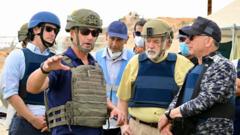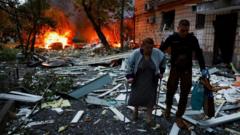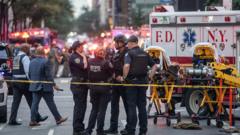A passenger plane and military helicopter collided near Washington DC, resulting in a tragic loss of life and raising questions about aviation safety protocols and air traffic control measures.
Tragic Collision: What We Know About the Washington DC Plane Crash

Tragic Collision: What We Know About the Washington DC Plane Crash
An in-depth analysis of the catastrophic mid-air collision involving a passenger jet and military helicopter that claimed numerous lives.
The horrifying mid-air collision claimed the lives of 67 individuals, including 64 passengers aboard the Bombardier CRJ700 operated by American Airlines, which had originated from Wichita, Kansas. The crash occurred on Wednesday evening, near Ronald Reagan Washington National Airport. Preliminary investigations suggest that the Sikorsky H-60 Black Hawk helicopter from Fort Belvoir was reportedly flying above the designated altitude prior to the incident.
Authorities have commenced recovery efforts, retrieving flight data recorders from the American Airlines aircraft, while search teams continue to scour the icy Potomac River where the aircraft crashed. The investigation remains ongoing, focusing on the circumstances leading to the crash.
Eyewitness accounts reveal distressing images; one observer noted the plane's alarming descent, claiming to see sparks beneath as it veered off course. Rescue operations faced treacherous conditions due to floating ice in the river, complicating recovery efforts which have so far located 41 bodies, including three from the helicopter.
Who were the victims? The passenger list included reputable figure skaters and a pilot, among others. Several families have begun identifying their loved ones, expressing grief over the loss.
The investigation has yet to identify a definitive cause for the crash. The National Transportation Safety Board (NTSB) is set to investigate the data recovered from the cockpit and square reports on air traffic control procedures at the moment of the incident. Preliminary reports indicate that staffing levels at air traffic control were lower than usual, raising concerns over oversight in a busy airspace.
President Trump has expressed his views on the matter, suggesting the helicopter was operating well above the legal altitude limit and attributing the tragedy to procedural failures within the FAA. He further called for an immediate overhaul of air traffic procedures and personnel.
While major incidents such as this are uncommon in the United States, the airspace above DC is densely populated with civilian, military, and government-sanctioned flights, all of which must adhere to stringent safety regulations.
The investigation continues to unfold, and further information will be crucial in understanding the full array of factors contributing to this tragic event.
Authorities have commenced recovery efforts, retrieving flight data recorders from the American Airlines aircraft, while search teams continue to scour the icy Potomac River where the aircraft crashed. The investigation remains ongoing, focusing on the circumstances leading to the crash.
Eyewitness accounts reveal distressing images; one observer noted the plane's alarming descent, claiming to see sparks beneath as it veered off course. Rescue operations faced treacherous conditions due to floating ice in the river, complicating recovery efforts which have so far located 41 bodies, including three from the helicopter.
Who were the victims? The passenger list included reputable figure skaters and a pilot, among others. Several families have begun identifying their loved ones, expressing grief over the loss.
The investigation has yet to identify a definitive cause for the crash. The National Transportation Safety Board (NTSB) is set to investigate the data recovered from the cockpit and square reports on air traffic control procedures at the moment of the incident. Preliminary reports indicate that staffing levels at air traffic control were lower than usual, raising concerns over oversight in a busy airspace.
President Trump has expressed his views on the matter, suggesting the helicopter was operating well above the legal altitude limit and attributing the tragedy to procedural failures within the FAA. He further called for an immediate overhaul of air traffic procedures and personnel.
While major incidents such as this are uncommon in the United States, the airspace above DC is densely populated with civilian, military, and government-sanctioned flights, all of which must adhere to stringent safety regulations.
The investigation continues to unfold, and further information will be crucial in understanding the full array of factors contributing to this tragic event.





















